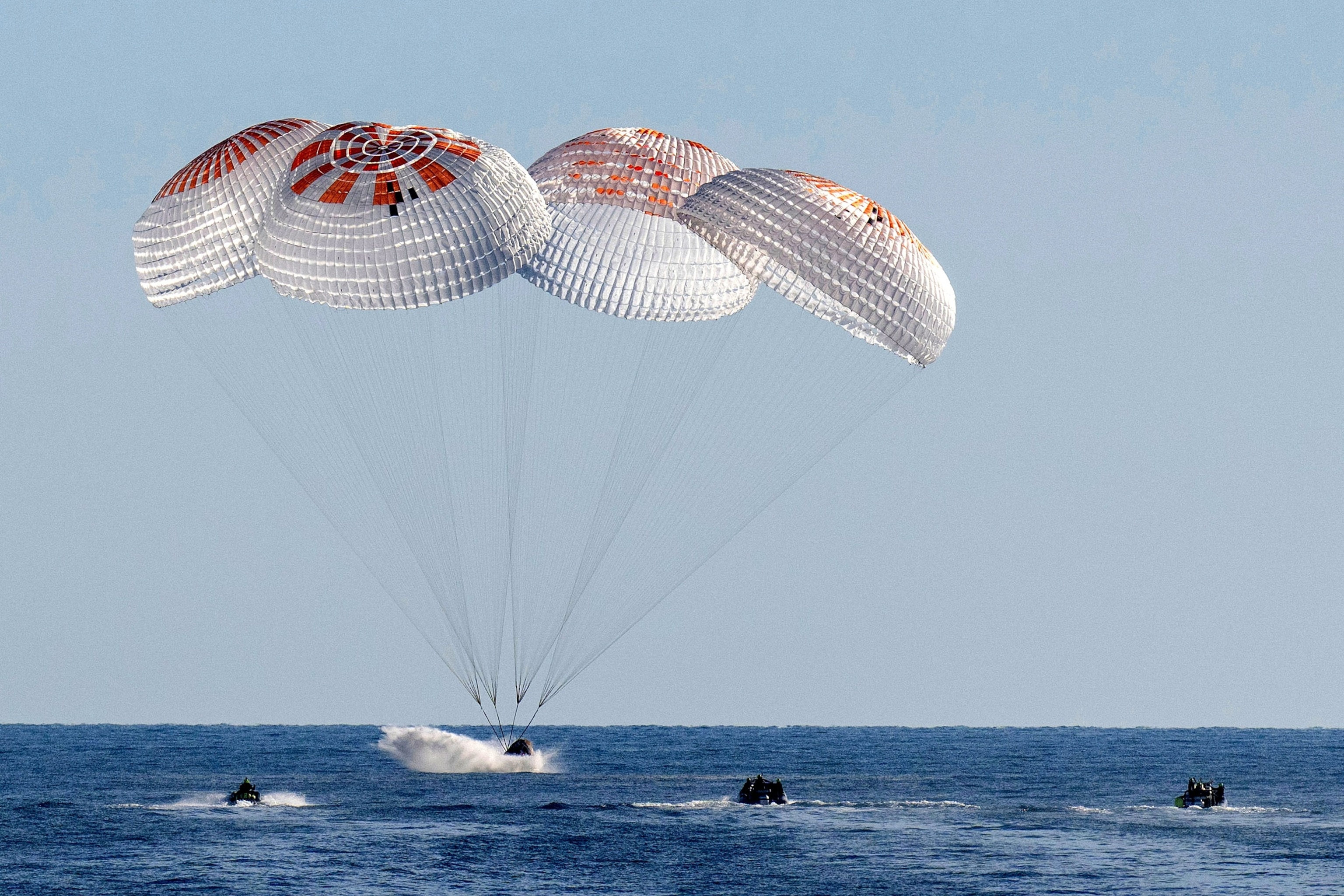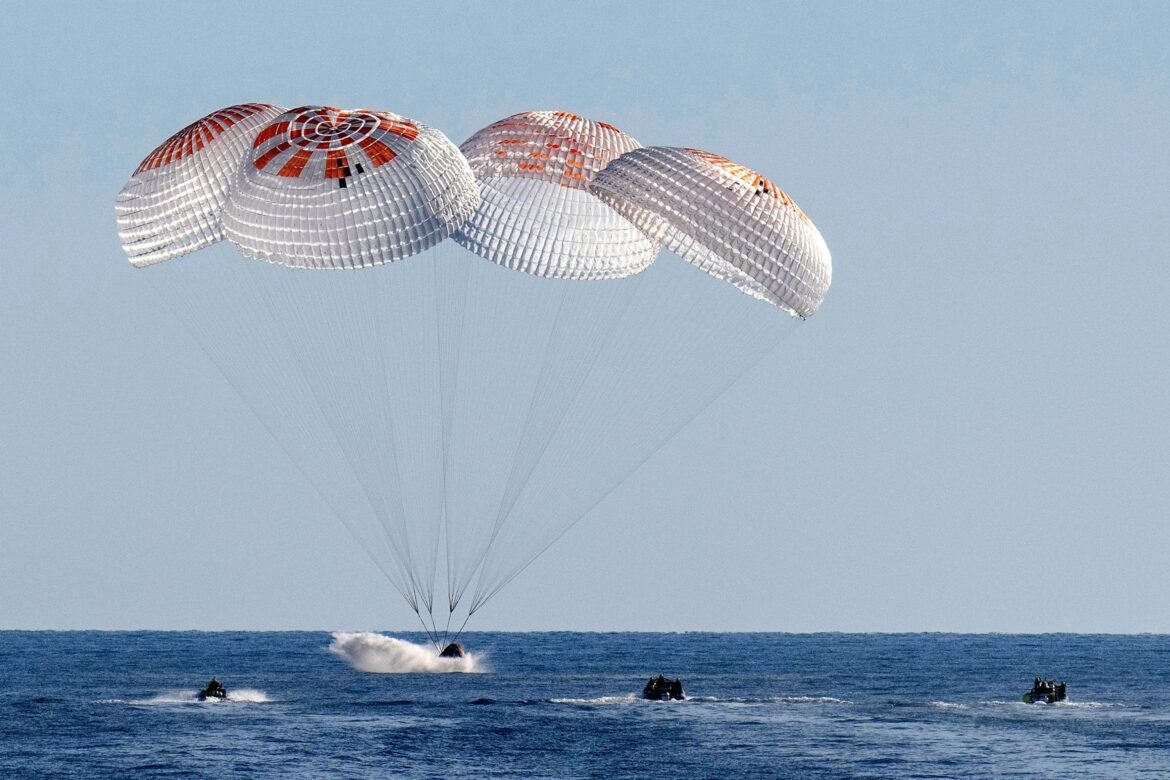The two NASA astronauts whose eight -day stops at the International Space Station (ISS) became a mission of nine and half a month are finally back on Earth.
On Tuesday at 5:57 PM EDT, Spacex Dragon Freedom splashed on the coast of Tallahassee, Florida, taking Sunita ‘Suni’ Williams and Butch Wilmore along with Nasa Nasa Hague astronaut and Roscosmos Cosmonaut Aleksandr Gorbunov.

In this image provided by NASA, a Spacex Space Capsula on the coast of Florida, on March 18, 2025, while landing off the Florida coast with NASA Suni Williams, Butch Wilmore and Nick Hague, and Russian cosmonaut Alexander Gorbunov.
Keegan Barber/Nasa through AP
It was an idyllic day to return to Earth on Tuesday, with astronauts splashing at 78 degrees Fahrenheit Weather. There was also a capsule of curious dolphins swimming around the capsule while the earth teams prepared the capsule that would open after landing.
The capsule was finally taken from the water and was placed in a recovery ship where astronauts finally had their first fresh air breath in more than nine months.

On this video screen, a dolphin swam next to the crew dragon capsule off the coast of Florida, on March 18, 2025.
Is on television
Williams and Wilmore had made the first flight of the Boeing Starliner capsule in June 2024. On the other hand, what was expected to be a one -week trip to the ISS became a nine -month stay. The Boeing Starliner who was expected to take them home after about 10 days of experienced problems, leaving the couple at the season for months.
The early hours of Tuesday, the Spacex dragon that transported Williams, Wilmore, Hague and Gorbunov autonomously discounted from the ISS at 1:05 am et and began his 17 -hour trip return to the earth.
While the dragon separated from the ISS, crew astronauts and ISS shared farewells and good wishes on the radio. Dragon’s commander, Nick Hague, told the ISS crew: “On behalf of the crew-9, I would like to say that it was a privilege to call the station home. Live and work and be part of a mission and a team that covers the world working together in cooperation for the benefit of humanity.”

A dragon crew capsule that transports Butch Wilmore and Suni Williams, two NASA astronaut veterans who have been trapped at the International Space Station for nine months, and Roscosmos Cosmonaut Aleksandr Gorbunov and NASA’s astronaut Nas I returned to return to returned to return to returned to return to return to the March 18, 2025.
NASA through Reuters
His return spacecraft maneuvered in space, moving above and behind the station, before shooting a series of exit burns that sent him back to the earth.

Astronauts are seen inside to Spacex Crew Dragon Capsule Carrying Butch Wilmore and Suni Williams, Two Veteran Nasa Astronauts Who Have Been Stuck on The International Space Station for Nine Months, and Roscosmos Cosmonaut Aleksandr Gorbunov and Nas Undocked from the ISS To Begin a Journey to return to Earth March 18, 2025, in This Still Image taken from the video.
NASA through Reuters
After completing his trip from the ISS and preparing for the re -entry, the dragon made a burn of Deorbit using his Draco propellers to change the course of the vehicle and put it on the right path to re -enter the atmosphere of the earth and land in the location designated on the coast of Florida.
After the burn, the dragon began its re -entry, a period in which the spacecraft is attached to extreme heat, up to 3,500 degrees Fahrenheit and drag. To keep the astronauts safe, Dragon uses a heat shield to prevent burning during the re -entry. The drag helped reduce the speed of the vehicle, so it was safe to deploy its parachutes.
Dragon then used two parachute sets to delay it more before splashing.
The first two chutas of drugs, also called Drag Chute, are designed for high speeds and deployed at approximately 18,000 feet, while the ship was traveling to almost 350 miles per hour.
That slowed the vehicle significantly but not enough for a safe landing. At about 6,000 feet, the four main parachutes were successfully deployed and slowed down the spacecraft to a 15 -mile safe per hour before the Coast of Tallahassee splashed.
Matthew Glasser and Mary Kekatos of ABC News contributed to this report.


